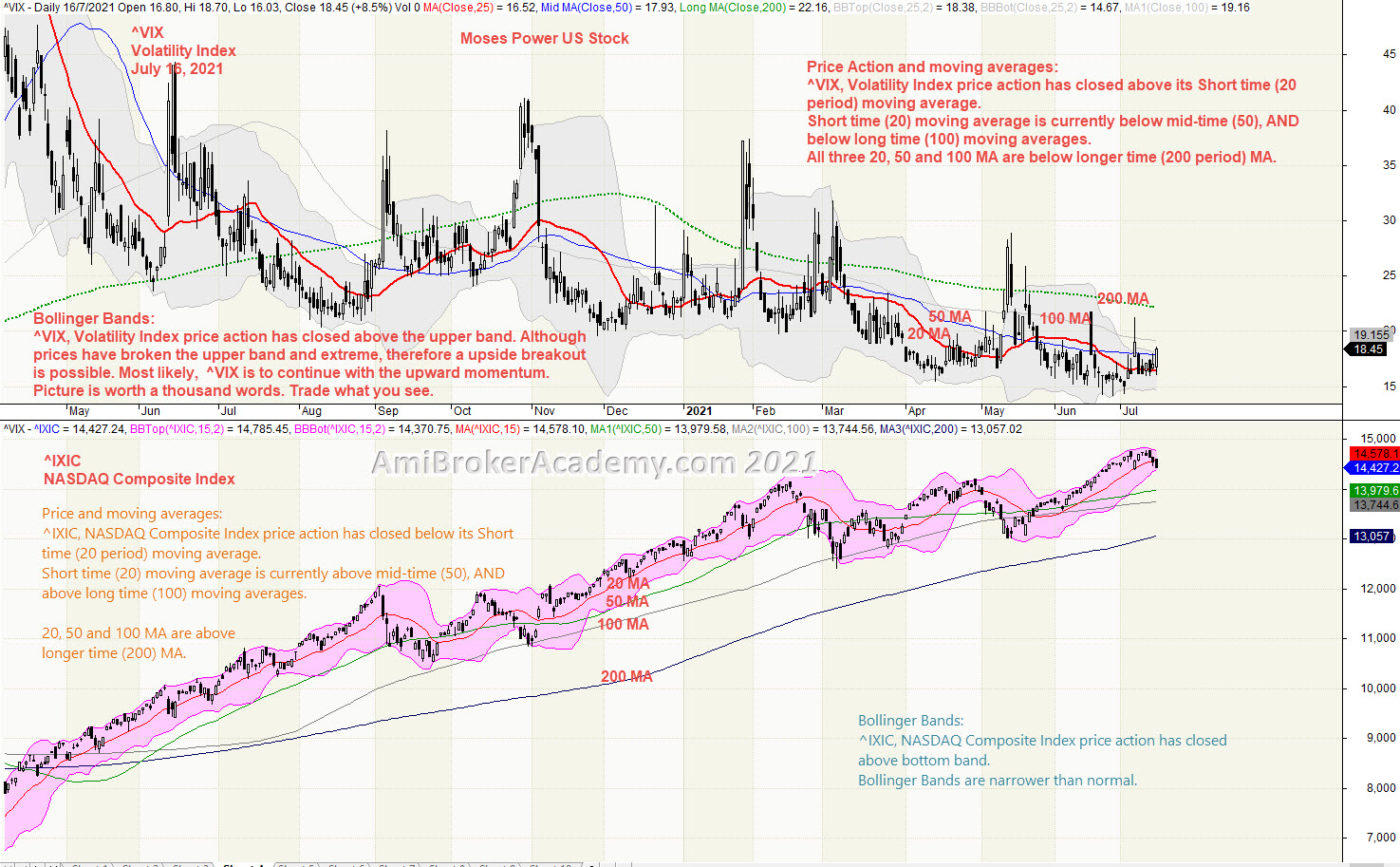21 July 2021
Welcome!
Welcome to AmiBroker Academy dot com, amibrokeracademy.com.
We sometime bench mark two stock price action or stock price with index. The following example, we benchmark Volatility Index and US NASDAQ Composite stock index. Besides correlation we use other tools such as 1) Ichimoku Cloud, 2) Support Resistance (using box), 3) River (moving average), 4) GMMA and Woodies CCI, 5) Bollinger Bands and Moving Averages, and 6) MACD to analyze chart. See our simple reading of price action.
We also apply wave theory onto chart. Such as well know Elliott Waves. Just in case you are not familiar with Elliott Waves. Elliott was from Ralph Nelson Elliott.
Otherwise, we like to use pattern, such as ABCD pattern. Checkout our posting here for more.
We translate price action chart into layman language. This will help you in understand the financial instrument you are trading. We believe picture worth a thousand words. So, sometimes we use less words. You can learn the price action interpretation too. Give it a tray. You may not have the same view points as us. Remember all analysis read price action chart differently. It is just like reading an essay, we will have different conclusion.
Trade what you see. Manage your risk. Trade well.
1) Volatility Index and NASDAQ Composite Index Correlation
We study price action we see Volatility Index price action begin to go from high to low. Price Action try to breakout higher but fail. We see NASDAQ Composite Index price action just continues to go from low to high. Benchmark both Volatility Index and NASDAQ Index, you can see one has the bear trend and the other bull.
Volatility Index is used to indicate the market fear. Looks the the fear factor is low. Although occasionally, the fear pop up. Manage your risk. And Trade what you see.
Price Action and moving averages:
^VIX, Volatility Index price action has closed above its Short time (20 period) moving average.
Short time (20) moving average is currently below mid-time (50), AND below long time (100) moving averages.
All three 20, 50 and 100 MA are below longer time (200 period) MA.
Bollinger Bands:
^VIX, Volatility Index price action has closed above the upper band. Although prices have broken the upper band and extreme, therefore a upside breakout is possible. Most likely, ^VIX is to continue with the upward momentum. Picture is worth a thousand words. Trade what you see.
Price and moving averages:
^IXIC, NASDAQ Composite Index price action has closed below its Short time (20 period) moving average.
Short time (20) moving average is currently above mid-time (50), AND above long time (100) moving averages.
20, 50 and 100 MA are above
longer time (200) MA.
Bollinger Bands:
^IXIC, NASDAQ Composite Index price action has closed above bottom band.
Bollinger Bands are narrower than normal.
Remember, we just read what the chart said. Have fun!

Moses Power Charting
Official AmiBrokerAcademy.com Charting
Disclaimer
The above result is for illustration purpose. It is not meant to be used for buy or sell decision. We do not recommend any particular stocks. If particular stocks of such are mentioned, they are meant as demonstration of Amibroker as a powerful charting software and MACD. Amibroker can program to scan the stocks for buy and sell signals.
These are script generated signals. Not all scan results are shown here. The MACD signal should use with price action. Users must understand what MACD and price action are all about before using them. If necessary you should attend a course to learn more on Technical Analysis (TA) and Moving Average Convergence Divergence, MACD.
Once again, the website does not guarantee any results or investment return based on the information and instruction you have read here. It should be used as learning aids only and if you decide to trade real money, all trading decision should be your own.
We learn from many past and present great traders. Kudo to these master.
